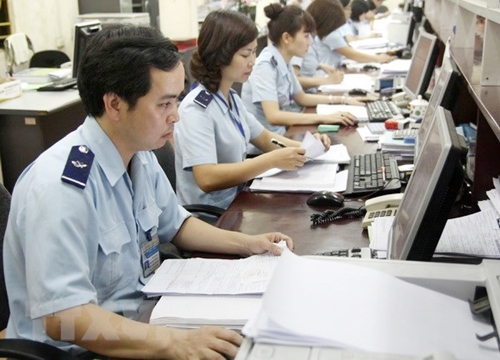Speaking at a workshop in Ho Chi Minh City on May 28, Thai said the customs sector would reform administrative procedures, modernize customs, improve the business environment and enhance national competitiveness.
Thai said the Ministry of Finance had recently submitted to the Government a draft decree on preferential export tariffs and special preferential import tariffs under the CPTPP agreement for 2019-2022.
The General Department of Vietnam Customs is also finalizing amendments and supplements to Circular 38/2018/TT-BTC on inspection and identification of goods origin, which is expected to be completed in June and will be submitted to the Ministry of Finance for approval, he added.
Thai said there are some notable issues brought by the deal, including the fact CPTPP members committed to eliminating 97 percent to 100 percent of tariff lines for goods imported from Vietnam.
    |
 |
|
Customs officials in the Northern city of Hai Phong |
In contrast, Vietnam also pledged to eliminate tariffs on 86.5 percent of tariff lines on imported goods from member countries within three years, but still maintains tariff quotas on some items such as sugar, eggs, salt and used cars, Thai said.
He said the CPTPP inherited its advanced rules of origin and origin procedure from the Trans-Pacific Partnership, encouraging the integration of member countries and aiming to form a complete supply chain.
Meanwhile, Thai said the procedure for certification of origin would be simplified, as the deal allows the origin of goods to be certified by manufacturers, exporter or importers.
Traditionally, the certificate of origin must be issued by the competent authority of the exporting country or the manufacturing country, Thai said.
At the workshop, experts discussed tax policies and customs procedures as well as rules of origin of goods in the CPTPP.
Director of the Ministry of Finance’s International Cooperation Department Vu Nhu Thang said that when Vietnam joins the CPTPP, its exports to the member countries would enjoy import tax incentives.
This is a good condition for Vietnamese enterprises to access new markets, especially its advantageous products such as seafood, textiles, footwear and agricultural products, Thang said, adding that however, opportunities also come with challenges as businesses have to compete with goods of importing countries in Vietnam.
Tran Van Cong, Deputy Director of the Ministry of Agriculture and Rural Development’s Agro Processing and Market Development Authority, said Vietnam needed to step up the building of a national standard and regulation system, trademarks and national brands.
Authorities need to have a plan for the cuts of import and export taxes of members in the CPTPP for Vietnamese goods so that enterprises could have timely response plans, Cong said.
The CPTPP agreement gathers 11 member countries, namely Australia, Brunei, Canada, Chile, Japan, Malaysia, Mexico, New Zealand, Peru, Singapore and Vietnam.
The deal took effect from December 30, 2018, while Vietnam ratified the agreement on January 14, 2019.
Under the trade pact, Vietnam’s GDP is expected to increase by 1.32 percent annually, while export turnover may increase 4.04 percent and import turnover by 3.8 percent.
Source: VNA